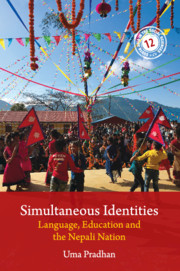Book contents
- Frontmatter
- Contents
- List of Figures
- List of Tables
- List of Appendices
- List of Abbreviations
- Acknowledgements
- Notes on the Use of Terms, Transliteration and Names
- Introduction: Language, Education and the Nepali Nation 1
- 1 Language, Education and State-Making in Nepal
- 2 Mother Tongue and the Construction of an Educated Person
- 3 Language, Public Space and Identity
- 4 Transforming Language to a Script
- 5 Language, Education and Knowledge-Making
- 6 Quality, Equality and Language Ideology
- 7 Ethnicity, Education and Employment
- Conclusion: Simultaneous Identities
- Appendices
- Glossary
- Bibliography
- Index
4 - Transforming Language to a Script
Published online by Cambridge University Press: 30 April 2020
- Frontmatter
- Contents
- List of Figures
- List of Tables
- List of Appendices
- List of Abbreviations
- Acknowledgements
- Notes on the Use of Terms, Transliteration and Names
- Introduction: Language, Education and the Nepali Nation 1
- 1 Language, Education and State-Making in Nepal
- 2 Mother Tongue and the Construction of an Educated Person
- 3 Language, Public Space and Identity
- 4 Transforming Language to a Script
- 5 Language, Education and Knowledge-Making
- 6 Quality, Equality and Language Ideology
- 7 Ethnicity, Education and Employment
- Conclusion: Simultaneous Identities
- Appendices
- Glossary
- Bibliography
- Index
Summary
‘Earlier they used to speak phohor (unclean) and je pāyo tyehi (unsystematic) Tharu. Now they speak rāmro (good) Tharu while also learning Nepali’, one of the parents told me as he described his child's progress in JKHSS. As discussed earlier, JKHSS had been using Dangaura Tharu – the language spoken by 90 per cent of the student population – as the language of instruction for all subjects in Grades I–III. In line with this, JKHSS also developed a set of textbooks using three different languages – Tharu, Awadhi and Nepali – simultaneously. In both JKHSS and JSB, the publication of textbooks was an important element in the process of creating institutional spaces for the official use of local languages other than Nepali and English in the school premises. However, this chapter primarily draws on MLE textbooks used by JKHSS as these books were still in the process of development and thus allowed me to follow the dynamics during its production. As I inquired further about the MLE books, the vice principal of the JKHSS, who is also the chief editor of textbooks, explained the process of MLE implementation and textbook preparation: ‘When we started mother-tongue education in our school, we refined our language (parimarjit garya); we removed “bad words”, systematised it and made it suitable for the textbooks’ (vice prinicipal of JKHSS, interview, 3 January 2014). Drawing onthe provisions made in various provisions in the national and international law, the language activists and school administration had standardised the language and produced it in the form of textbook for the purpose of schooling.
This apparent sanitisation of the language is one of the ways in which JKHSSS prepared the Tharu language for school education. The practice of removing what are seen to be profanities, jargon, bad grammar and mispronunciations – a process also known as ‘linguistic hygiene’ – is a result of an urge to improve and clean up language (Cameron, 1995). In JKHSSS, this process of cleansing the language was animated by three main challenges. First, while the MLE programme opened up official space for minority language education in JKHSSS, it also put a spotlight on its putative lack of appropriate vocabulary, standardisation and grammar.
- Type
- Chapter
- Information
- Simultaneous IdentitiesLanguage, Education, and the Nepali Nation, pp. 113 - 137Publisher: Cambridge University PressPrint publication year: 2020



